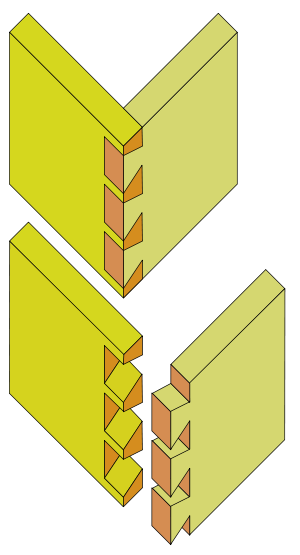 |
| English: Diagram of a Dovetail Joint (wood). Created by --Etune End-grain is shown in darker colors. (Photo credit: Wikipedia) |
Imagine if you will, drawing a shape on a piece of paper such as a circle freehand vs drawing the same shape by tracing a pattern. Which process will achieve a better result? Of course, tracing a pattern. This same principal is used when incorporating jigs into the woodworking process.
Shop jigs are great for repetitive tasks with any wood working project. They make production of complex projects easier to manage. Woodwork jigs are available commercially or you can build your own. Although many woodworking jigs are inexpensive, making your own from scrap wood is even cheaper. Depending on the type of projects you like to do, you will need a variety of different jigs.
A jig can be as simple as a straight edge, which guides a circular saw or router for making straight cuts with ease. Or a jig can be more complicated such as a Leigh dovetail jig. Each time I use the Leigh dovetail jig, I have the instruction manual nearby for technical support.
Some woodworking jigs you simply can not buy, you'll have to make them in your wood shop. However, you'll be surprised at how simple many of these jigs are to build yourself.
Types of Woodworking Jigs
Dovetail jigs are great for making dovetail joints accurately and fast. There are a few types that are relatively inexpensive, the Woodstock D2796 12" dovetail jig for example.
However, the Leigh dovetail jig is not. I suppose that you could make your own dovetail jig but I wouldn't suggest doing so, because in my experience the accuracy and durability provided by the factory made jig can not be matched in the woodworking shop.
There are plenty of other shop made jigs you can build to increase production and accuracy. "You can never have enough of them", as the saying goes.
"Jigs & Fixtures" is a good read if you're looking for a comprehensive guide that covers shop built woodworking jigs .
Circle cutting jigs are easy to make for use with a band saw. Another simple jig, which I use quite often, is a box joint or finger joint jig. This jig is used with a router and a spiral cutting router bit. I make this jig on the table saw using dado blades. It’s very simple, I’ll talk about how to make that jig is another post.
Consider the cut off sled, this is a jig used on a table saw to accurately cross cut wood pieces at a 90 degree angle or in other words to square an end. Used with a stop block, one can cut several cabinet sides (for example) to the exact same length without having to measure each individual piece. A simple stop block can also be used in conjunction with the power miter box (A.K.A.), the chop saw to cut numerous pieces of stock (example), cabinet stiles and rails.
A favorite of mine is the Kreg pocket hole jig, which is used to assemble face frames on cabinets.
A dowel jig is used for drilling accurate dowel holes. That is to say, the holes are perpendicular (right angle) to the wood's surface. Personally, I don't use dowels much. The mortise and tenon, dovetail joint, biscuit cutter or pocket holes are my preferred methods of fastening and alignment of wood parts.
 |
| Use a box joint jig to make beautiful boxes |
There are benefits to making your own woodworking jigs. The number one benefit is increased accuracy and speed of building projects. When used properly, the task of marking exact measurements for each individual piece is eliminated. Building jigs also makes good use of scrap material. There are hundreds of jigs one can make and implement into their woodworking projects.
You can find instructions for making your own jigs in woodworking books or magazines. Instructions are also available on the Internet. You can print these instructions out for future reference. Consider getting a binder to keep your jig making instructions organized in your workshop. The ability to build and use jigs in the shop separates the novice from the highly skilled woodworker.
Learn more about shop jigs that benefit the woodworker
- Hinge mortise jig for replacing doors
- Learn how to make a box joint jig
- How to use a pocket screw jig
- Circle cutting router jigs
Tweet


No comments:
Post a Comment